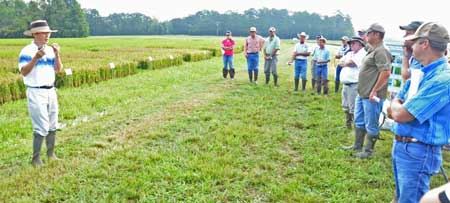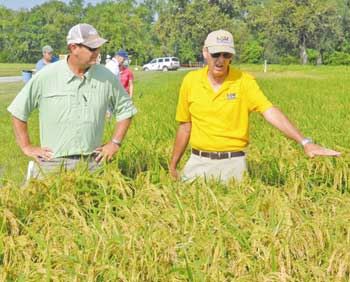|
Rice Farmers Learn Latest On Disease
CROWLEY, LA.
LSU AgCenter scientists held a field tour at the Rice Research Station here on Aug. 26 to discuss their work on controlling the major diseases that afflict rice.
Clayton Hollier, AgCenter plant pathologist, said even varieties with the best resistance can be affected by disease.
“Resistance is not immunity,” Hollier said.
But, he said, resistance is likely to result in higher yields than varieties that are susceptible to diseases.
Hollier said he is studying how different fungicide application times and planting dates could affect yields.
He said Cercospora is an overlooked disease that damaged many crops in 2006. The disease known as narrow brown leaf spot is caused by Cercospora, he said, which overwinters in crop residue.
Jong Ham, AgCenter plant pathologist, is studying ways of controlling bacterial panicle blight. He said biological controls that suppress development of the disease have been identified that will be studied.

Jong Ham, LSU AgCenter plant pathologist, far left, talks
about his work on the disease
bacterial panicle blight. He
said a number of different
control measures are being studied
to fight the disease on rice, but he
said early planting and early
harvest are methods of controlling the
disease.
Photos by Bruce Schultz

Don Groth, LSU AgCenter plant pathologist, at right, talks
with crop consultant Doug Leonards about disease research
being
conducted at the Rice Research Station. Groth has research
plots at the
station that show effectiveness of different fungicides
on the most
popular rice varieties grown in the Midsouth.
Ham said rice breeding includes development of resistant lines. He said the most resistant variety is the medium-grain Jupiter, developed at the Rice Research Station.
But, he said, even a variety with bacterial panicle blight resistance will lose 10-15 percent of its yield if it is infected by the disease.
“It is a challenge to get resistance to all diseases,” he said.
Planting and harvesting early are keys to reducing the bacterial panicle blight problem, he said.
Don Groth, AgCenter plant pathologist, discussed how the major varieties grown in the U.S. are affected by disease and how they respond to fungicide applications. He said he inoculates research plots with bacterial panicle blight and sheath blight, but not for blast because it is spread by wind, and he doesn’t want to risk infecting nearby fields. ∆
|
|